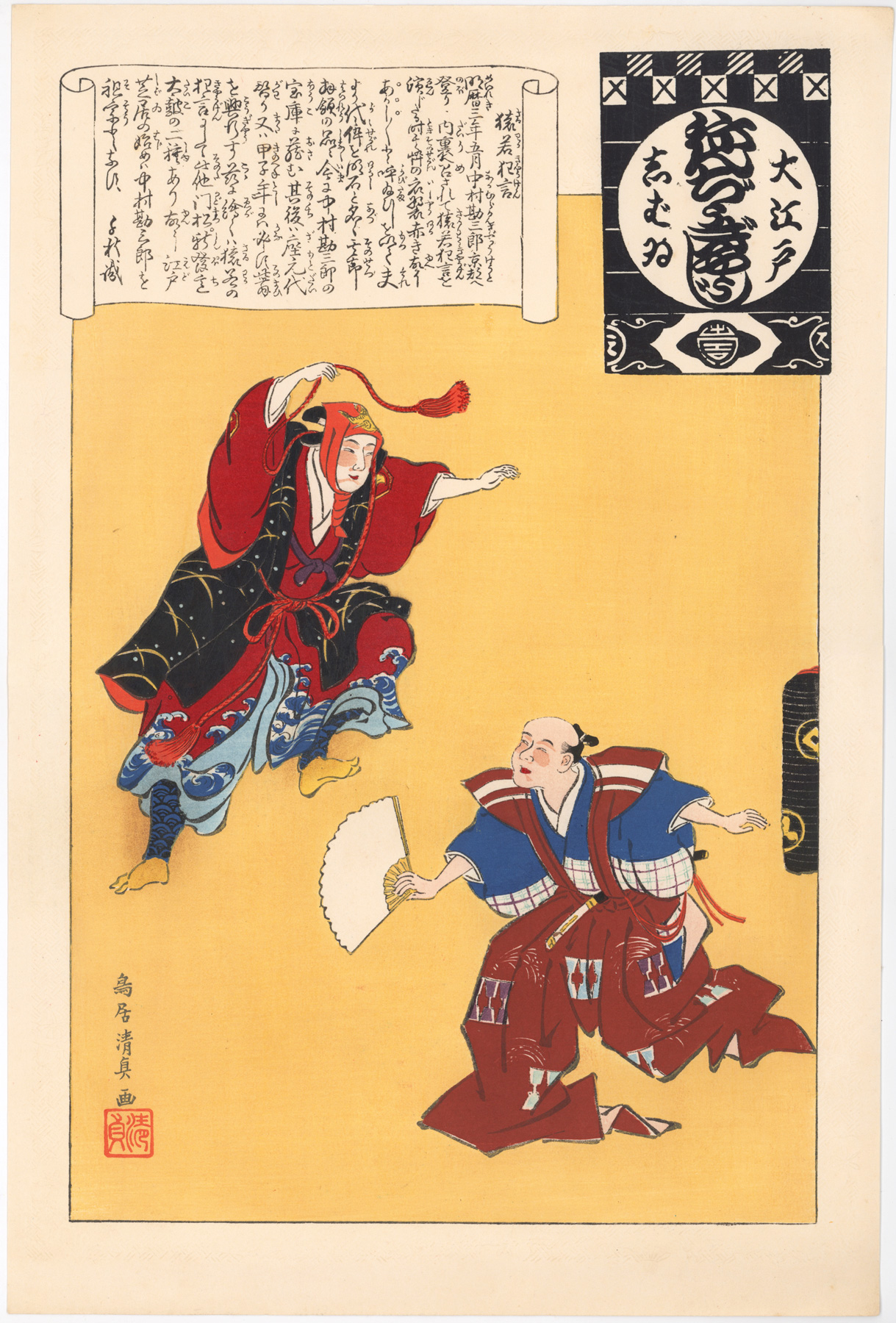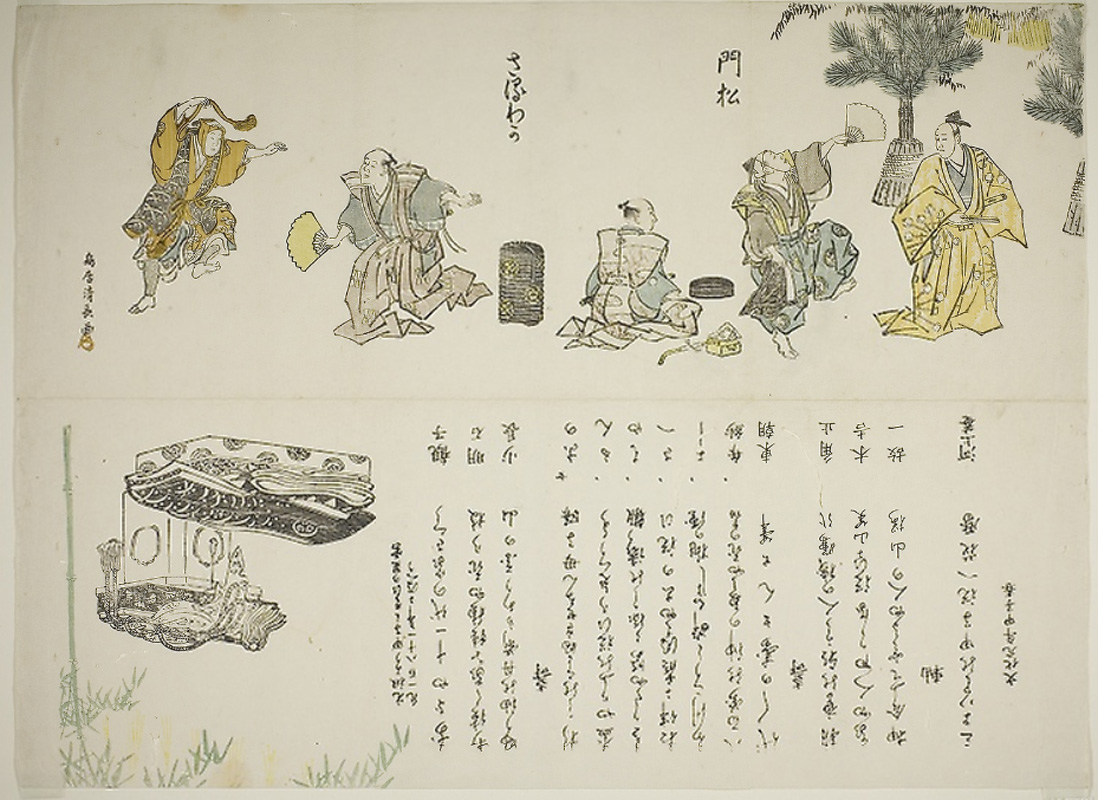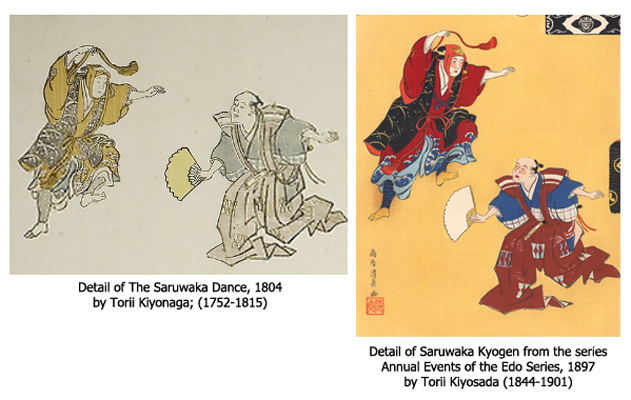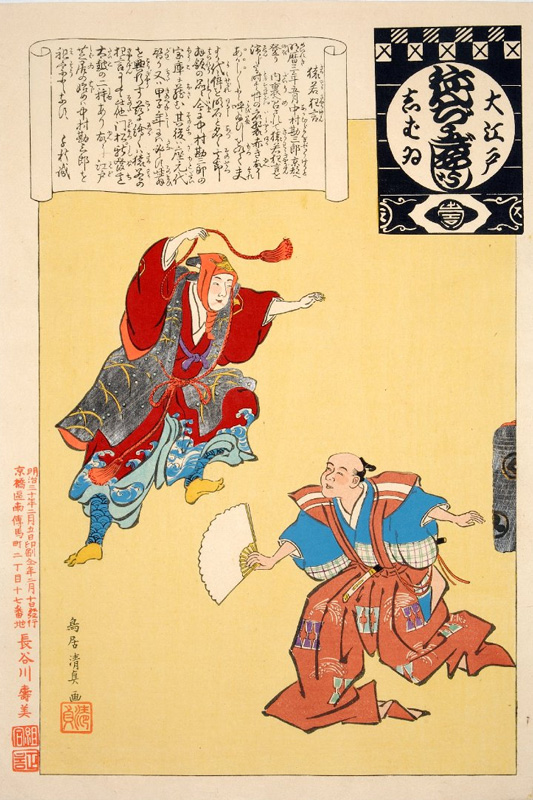About This Print
One of two prints designed by Torii Kiyosada for this twenty-five print series (plus a prolog/index print) picturing events in a typical year in an Edo theater. This print depicts the comic dance pantomime known as saruwaka kyōgen and Kiyosada copied this design from one of the earlier Torii masters, Torii Kiyonaga (1752-1815), as shown below.The Saruwaka Dance, 1804 by Torii Kiyonaga, 1804
Dimensions: 38.3 x 52.9 cm (15 1/8 x 20 7/8 in.)
Color woodblock print; surimono
Art Institute Chicago 1939.1701a&b
Detail of 1804 and 1897 prints
Kabuki Saruwaka
Saruwaka kyōgen is a dance in the style of the kyōgen of the No theatre that found its way into Kabuki.
"The earliest kabuki saruwaka involved the actor’s participation in chaya asahi (“visit to a teahouse”) scenes, in which a dashing fellow (played by Okuni) went to a teahouse accompanied by his servant, the saruwaka, who wore a tenugui kerchief covering his cheeks; a rough, wide-sleeved, single layer kimon (hitoe), and leggings (kyahan). The plot involved the star’s encounter with the teahouse proprietress (kaka), played by a kyōgen actor (the kyōgenshi). There was a banquet and the characters sang and danced a kouta.
About This Series
Source: Tokyo Metropolitan Library http://www.library.metro.tokyo.jp/Portals/0/edo/tokyo_library/english/modal/print.html?d=20; ARC http://www.arc.ritsumei.ac.jp/lib/vm/kabuki2015_e/2015/11/oedo-shibai-nenjyu-gyoji.html and from personal observation.
Ōedo Shibai Nenjū Gyōji (Annual Events of the Edo Theater) drawn by Adachi Ginkō (active 1873-1902) [with two prints, Yomitate (Public Reading) and Saruwaka Kyōgen, contributed by Torii Kiyosada (1844-1901)] is a set of twenty-six prints (including an index/prologue page), depicting the manners and customs relating to Kabuki plays/theaters in the Saruwaka-chō, the Kabuki theater district which flourished until 1867, the first year of the Meiji Era. The Ritsumeikan Art Research Center posits that this series was issued in response to the public's "remarkable nostalgia for [the] Edo period, the 'Great Tokugawa Epoch'." It goes on to say that this series is a continuation of the many earlier Kabuki theater guidebooks which "introduce[d] not only about things on a stage but also properties, organization of theatres and backstage."
Three Editions
At least three editions of this series were released. One edition, likely the first edition, contains the publisher's name, Hasegawa Sumi, and associated publishing and printing information along the left margin. This first edition, with the publishing information, is often found bound into volumes, with the margins of the prints trimmed back. My guess is that these bound volumes were created by the publisher. Another edition, likely a second edition, uses an embossed border around the entire image which is not present on the earlier edition. Generally these second edition prints have wider margins than the first edition. It is possible that these second edition prints were sold by subscription. A third edition, which appears to be printed from new blocks, as differences in composition in each print can be seen, is a less elaborate printing than the earlier editions. Interestingly, this later edition uses the convention called komochiki of a thick notched line and thin black line framing the subjects, a popular Edo textile pattern thought to reflect iki taste (Edo chic). Use of this type of framing is associated with kōkanfuda, a type of votive offering print. (See IHL Cat. #1686 A Set of Three Nōsatsu Kōkanfuda - Fūjin the Wind God, Raijin the Thunder God, Calligraphic Cover Sheet for more information about kōkanfuda.)
Summary of Differences Between the Three Editions1. First edition prints contain the publishing and printing information, including dates, along the left margin. In the later edition of prints only the Index/Prologue print contains any publishing information, with the publishing house 長谷川 板 (Hasegawa han), proceeded by the publisher's address embossed in the lower left corner. No date is given on this print or any other later edition prints.2. Most first edition prints contain the artist's signature and/or seal. Later editions do not carry the artist's signature or seal.3. Second edition prints contain an approximately 1/2" wide embossed border around the entire image area not present on the first edition.4. Some second edition prints may have had the original blocks reworked.5. Third edition prints were printed from new blocks and all have a thick notched line and thin black line framing the subjects.
First Edition of This PrintThe below first edition print contains the publishing and printing information along the left margin that is absent from this collection's print.
At least three editions of this series were released. One edition, likely the first edition, contains the publisher's name, Hasegawa Sumi, and associated publishing and printing information along the left margin. This first edition, with the publishing information, is often found bound into volumes, with the margins of the prints trimmed back. My guess is that these bound volumes were created by the publisher. Another edition, likely a second edition, uses an embossed border around the entire image which is not present on the earlier edition. Generally these second edition prints have wider margins than the first edition. It is possible that these second edition prints were sold by subscription. A third edition, which appears to be printed from new blocks, as differences in composition in each print can be seen, is a less elaborate printing than the earlier editions. Interestingly, this later edition uses the convention called komochiki of a thick notched line and thin black line framing the subjects, a popular Edo textile pattern thought to reflect iki taste (Edo chic). Use of this type of framing is associated with kōkanfuda, a type of votive offering print. (See IHL Cat. #1686 A Set of Three Nōsatsu Kōkanfuda - Fūjin the Wind God, Raijin the Thunder God, Calligraphic Cover Sheet for more information about kōkanfuda.)
Summary of Differences Between the Three Editions
1. First edition prints contain the publishing and printing information, including dates, along the left margin. In the later edition of prints only the Index/Prologue print contains any publishing information, with the publishing house 長谷川 板 (Hasegawa han), proceeded by the publisher's address embossed in the lower left corner. No date is given on this print or any other later edition prints.
2. Most first edition prints contain the artist's signature and/or seal. Later editions do not carry the artist's signature or seal.
3. Second edition prints contain an approximately 1/2" wide embossed border around the entire image area not present on the first edition.
4. Some second edition prints may have had the original blocks reworked.
5. Third edition prints were printed from new blocks and all have a thick notched line and thin black line framing the subjects.
First Edition of This Print
The below first edition print contains the publishing and printing information along the left margin that is absent from this collection's print.
Print Details
IHL Catalog
#2015 Title or Description Saruwaka kyōgen 猿若狂言 (Saruwaka performance by the descendants Nakamura Kanzaburō) Series Annual Events of the Edo Theatre
Ō-Edo shibai nenjū-gyōji 大江戸しばゐねんぢうぎやうじ
Artist Torii Kiyosada (1844-1901) Signature  鳥居清貞筆 Torii Kiyosada hitsu
鳥居清貞筆 Torii Kiyosada hitsu Seal 清貞 Kiyosada (shown above) Publication Date 1897, February 10 (Meiji 30) note: The original publication date of the first edition is 1897. The publication date of this collection's print, a second edition, is unknown. Publisher Hasegawa Sumi 長谷川 寿美 [Publisher seal is not present on this print]
Engraver
unknown Impression excellent Colors excellent
Condition excellent
Genre ukiyo-e; yakusha-e
Miscellaneous an approximately 1/2" wide embossed pattern surrounds the image area
Format vertical oban
H x W Paper
15 5/16 x 10 1/8 in. (38.9 x 25.7 cm)
H x W Image
13 3/4 x 8 11/16 in. (34.9 x 22.1 cm)
Literature
Collections This Print
British Museum 1983,0523,0.3.22; Waseda University Cultural Resource Database 201-0701; Museum of Fine Arts Boston RES.53.31; National Diet Library Call Number 寄別8-4-2-1; Edo-Tokyo Museum (Tokyo Digital Museum 91970059); Tokyo Metropolitan Library 577-010-22ア; Art Research Center Ritsumeikan University arcUP2061
last update:2/15/2020 created
| IHL Catalog | #2015 |
| Title or Description | Saruwaka kyōgen 猿若狂言 (Saruwaka performance by the descendants Nakamura Kanzaburō) |
| Series | Annual Events of the Edo Theatre Ō-Edo shibai nenjū-gyōji 大江戸しばゐねんぢうぎやうじ |
| Artist | Torii Kiyosada (1844-1901) |
| Signature |  |
| Seal | 清貞 Kiyosada (shown above) |
| Publication Date | 1897, February 10 (Meiji 30) note: The original publication date of the first edition is 1897. The publication date of this collection's print, a second edition, is unknown. |
| Publisher | Hasegawa Sumi 長谷川 寿美 [Publisher seal is not present on this print] |
| Engraver | unknown |
| Impression | excellent |
| Colors | excellent |
| Condition | excellent |
| Genre | ukiyo-e; yakusha-e |
| Miscellaneous | an approximately 1/2" wide embossed pattern surrounds the image area |
| Format | vertical oban |
| H x W Paper | 15 5/16 x 10 1/8 in. (38.9 x 25.7 cm) |
| H x W Image | 13 3/4 x 8 11/16 in. (34.9 x 22.1 cm) |
| Literature | |
| Collections This Print | British Museum 1983,0523,0.3.22; Waseda University Cultural Resource Database 201-0701; Museum of Fine Arts Boston RES.53.31; National Diet Library Call Number 寄別8-4-2-1; Edo-Tokyo Museum (Tokyo Digital Museum 91970059); Tokyo Metropolitan Library 577-010-22ア; Art Research Center Ritsumeikan University arcUP2061 |
2/15/2020 created





